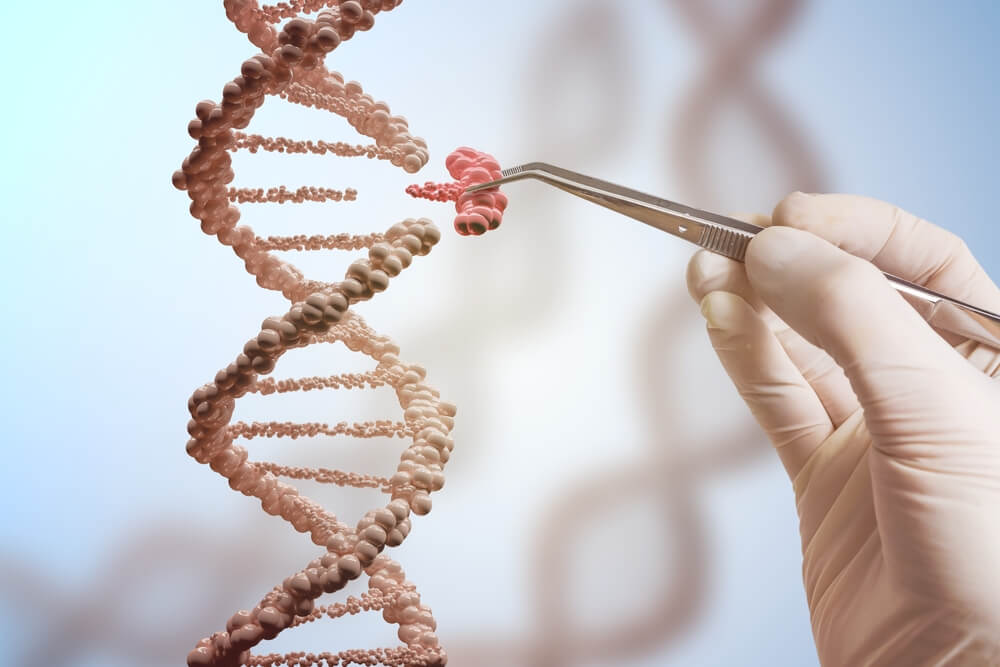Definition
Genetic engineering or genetic modification is a field of genetics that alters the DNA of an organism by changing or replacing specific genes. Used in the agricultural, industrial, chemical, pharmaceutical, and medical sectors, genetic engineering can be applied to the production of brewing yeasts, cancer therapies, and genetically-modified crops and livestock, among countless other options. The only criterion is that the modified product is – or once was – a living organism that contains DNA.

Genetic Engineering Examples
Examples of genetic engineering are listed according to sector in this article, where each sector applies DNA modification with a different goal. As the human genome contains between 20,000 and 25,000 genes and as these genes can extend from just a few hundred base pairs to over 2 million, the scope of genetic engineering is huge. However, there are lots of ethical questions that concern how far this kind of research should go and what applications are acceptable.
Chemical Industry
The chemical industry uses genetic engineering when it produces modified live microorganisms for chemical production. It is not possible to genetically engineer a chemical or material like an acid or a steel bar – they do not contain DNA; however, bacteria that produce acid, for example, can be genetically modified.
Natural chemical compounds are essential for the existence of life. These have been mimicked over the years by man-made (synthetic) copies. One example of genetic engineering in today’s chemical industry is an enzyme called protease. Protease engineering is the foundation of genetic modification in laundry detergent manufacturing.
Proteases are enzymes found in every living organism; their function is to catalyze (speed up) the breakdown of ester and peptide bonds that are found in many types of laundry stains. Protease genes give cells the manufacturing instructions for protease production inside the cell (protein synthesis). By manipulating these genes, we can change the ultimate form of the protease and some of its characteristics.
Earlier detergents did not have access to genetic-engineering technology but even then, researchers were able to modify proteases by selecting and producing the best strains. With genetic engineering, these enzymes can be further improved for even whiter whites. Once the gene for protease production was decoded it was possible to extract and modify it. Many modifications have been made that improve stain-removing results in varying pH and water temperature levels, for example.

Other genetic engineering examples in the chemical industry include less environmentally-damaging wastewater management. This involves modifying the genes of the many types of bacteria that digest waste without their leaving behind similarly harmful byproducts. Another example is manufacturing biodegradable plastics using genetically-modified strains of cyanobacteria.
Crop Production
Genetic engineering examples relating to crop production are often used to tell us why not to buy or eat them; however, a growing population without the time, space, or often the knowledge to produce crops at home means we need to use our agricultural land more efficiently. At the same time, it is important not to reduce natural habitats around the world. Genetically-modified (GM) crops are an answer in the form of increased crop yield on a smaller plot. Genetically modifying a crop concentrates on increased resistance to disease, increased fiber and nutrient content, or increased yield – preferably a combination of all three. If we can obtain all the minerals and vitamins we need from a super-tomato that grows very quickly without needing pesticides or fertilizers, and will even grow in drought conditions, then the topic of GM crops suddenly looks very attractive indeed.
A lot of negative public comments have caused genetically modified crops to be unpopular; many GM crops – even when legally grown – can’t find a big enough market. This means that farmers rarely want to take the financial risk to grow them.
There is no scientific evidence that a GM crop is dangerous to eat in comparison with a non-GM crop, but genetic engineering is quite new and we can’t say for sure if the long-term effects are harmful to humans or the animals that eat them (that we might then eat in our burgers). The only GM crop grown legally in the European Union (EU) is MON 810 maize. Production of this maize in the EU might also be banned in the future. Federal law in the US is strict concerning GM testing but the production, sale, and consumption of GM crops are legal.
Livestock
Genetic engineering examples in livestock rearing should always mention one Food and Drug Administration restriction that has recently been lifted. The import, sale, and raising of GM salmon eggs used to be banned in the US, although this wasn’t due to fears that eating these fish could be dangerous to our health – the ban was due to labeling laws. This ban has now been lifted.
In AquaAdvantage salmon, scientists combined the genes of Chinook salmon and the rather ugly ocean pout (below) to produce a continuously-growing salmon (salmon usually grows seasonally) that uses and requires fewer calories than wild or farmed alternatives. The company has spent twenty years testing this new food source; arguments against GM salmon’s use are usually based on the fact that twenty years is not very long in the average human lifespan.

While genetically modified beef is hard to find, it is still possible that your pot roast once ate GM feed. It might also have – when alive – been injected with genetically-engineered recombinant bovine growth hormone (rBGH). This hormone is also injected into dairy cows. It has been reported that milk from rBGH-treated cows contains higher levels of IGF-1, a hormone that seems to increase breast, prostate, colon, and lung cancer risk in humans. This is just one of the reasons why GM products are so controversial. But studies have also shown that the use of GM feeds increases health levels in animals and often means that farmers do not need to inject antibiotics and hormones into their livestock – as these chemicals can pass into the bloodstreams of the people that eat the livestock or drink their milk, this can be a doubly positive result. The jury is still out.
GM chicken is not available in your local supermarket (yet) but chickens fed with GM feeds are often labeled as such. So it is the digested residues of different genetically modified crops and not a genetically modified bird that is roasting in the oven.
Genetically modified chicken eggs are being studied as a future source of natural chemical compounds. Female chickens can be genetically engineered to produce eggs that contain larger amounts of certain proteins. These proteins are commonly used in the manufacturing processes of pharmaceutical drugs. Future drug prices could be much more affordable thanks to genetic modification technology.
Cancer Therapy
Genetic engineering examples in cancer therapy are already starting to show very positive results. The chicken egg makes an appearance here, too. In this field of genetic engineering, bacterial genes that produce particular proteins are modified. These proteins – you might have heard of the very heavily studied Cas9 protein – form antibodies that help to destroy viruses. This type of protein also supports a mechanism that alerts the immune response in humans. As this response is often suppressed by cancer cells, Cas9 might be able to help the body to recognize and then fight cancer. Cas9 is already being studied and trialed for genetic disorders such as sickle cell disease and cystic fibrosis.
Hereditary Disease
Hereditary diseases and disorders might become a thing of the past thanks to genetic engineering – there is just one problem, the ethical use of human embryos for research purposes.
Embryological genetic engineering is legal in some countries and these countries are given a lot of criticism. But when He Jiankui edited the genes of twin embryos and then had them implanted in a female who gave birth to these genetically-modified children, the world went crazy and Jiankui was subsequently jailed. Not only are the long-term effects of genetic engineering unknown, but any changes might carry through to subsequent generations or continue to change without the natural control that is evolution. For people who believe that life begins at conception or consider an embryo a living, conscious person, there are even more ethical arguments.
Many parents who undergo the process of in vitro fertilization (IVF) are offered the option of pre-implantation genetic diagnosis (PGD). This checks the DNA of the fertilized egg before it is inserted into the womb. The aim is to source possible genetic mutations. The parents are allowed to discard ‘faulty’ eggs. Many believe that this is very wrong as we have not agreed on what is considered an undesired mutation. A genetic fault that causes miscarriage would be acceptable, perhaps. But what about gender, hereditary mental illness, eye color? In the past years, several fertility clinics in India have been called out for promising male offspring to couples, for example. This is not an example of genetic engineering, but many groups fear that certain physiological choices may edge their way into genetic engineering without being controlled. Today, genetic modification in humans follows practically the same ethical arguments as abortion.

Pros and Cons of Genetic Engineering
The pros and cons of genetic engineering are not at all clear-cut. In the field of human genetic modification, our personal beliefs affect how this technology will develop and move forward. In countries where the law states that human life begins at week 24, the genetic engineering of embryos not carried to term is more likely to be accepted. This ethical question is part of what is known as the fetal personhood argument and is the main reason why genetic engineering in humans is meeting so much resistance.
In an agricultural setting, the public’s fears concern the long-term effects of eating GM foods. These fears stop farmers from producing modified crops as they might not be able to sell them and, in many countries, it is unlawful to grow them. Personal issues are often opinions; the actual pros and cons concern the results of long-term scientific research. Unfortunately, genome editing is a new technology and we do not have any data that covers more than a few years – certainly nothing that covers the lifetimes of one or more generations.
Pros
Genetic engineering pros should start with the fact that this topic has allowed us to learn so much more about our genes and the genes of other organisms. It is thanks to genetic engineering that we are learning how the entire range of DNA-containing organisms – from bacteria to humans – works.
Genetic engineering has given us fresh and unexpected knowledge that tells us how certain illnesses develop. The field has also provided targeted therapies that can cure or at least relieve these diseases. Not only the action of pharmaceuticals but also their cheaper production – as in the case of GM chicken eggs – can be made more efficient through this technology.
The combination of a growing global population and the need to maintain a very unstable ratio of agricultural land to natural habitats has led to the development of genetically-engineered crops. These crops are designed to have a greater yield, use fewer nutrients to grow, and require less acreage or fewer chemicals (herbicides and pesticides). Scientists can even improve taste, nutritional values, colors, and shapes.

Genetically-modified bacteria help to produce bio-fuels from genetically-modified crops. Bio-fuels reduce the effects of fossil fuel pollution. Cyanobacteria help us to produce biodegradable plastics and other GM microorganisms break down our waste. Genetic modification is strongly linked to our ecology and future.
And we use less of the earth’s resources when our livestock grows more quickly. When beef cattle grow to full size in one year instead of two or three, that is two years off of every animal’s carbon footprint. When bovine genes are modified to fight disease, our milk and meat have less antibiotic and hormone residue. Genetic engineering means less pressure to turn important, disappearing natural ecosystems into food-production factories.
Cons
The cons are mainly based on the lack of long-term studies into the effects of genetic engineering, both on an organism and on the organisms that eat it. Maybe even those that live alongside it. As with all new but potentially damaging technology, we just don’t have enough data.
Another factor is that, although we have decoded the human genome, we do not know everything we need to about every function in the human body. For example, the gut microbiome is a quite recent hot topic. Scientists now accept that bacteria in the gut directly affect the brain – which was rarely the case ten years ago. But exactly how the neurotransmitters of the brain interact with chemicals in the digestive tract is still a mystery. Examples like this mean that many people argue we should not try to fix something if we don’t know exactly how it works, know what the long-term effects will be, or know if it is actually broken in the first place.
There are other hurdles, of course. Before knowing whether genetic engineering can safely eliminate a fatal disorder forever, we have to figure out if it is right to change the DNA of embryos, let them grow and be born, and then research their lives from birth to old age (and maybe their children and grandchildren, too) so that we can ensure the new cure is safe.

